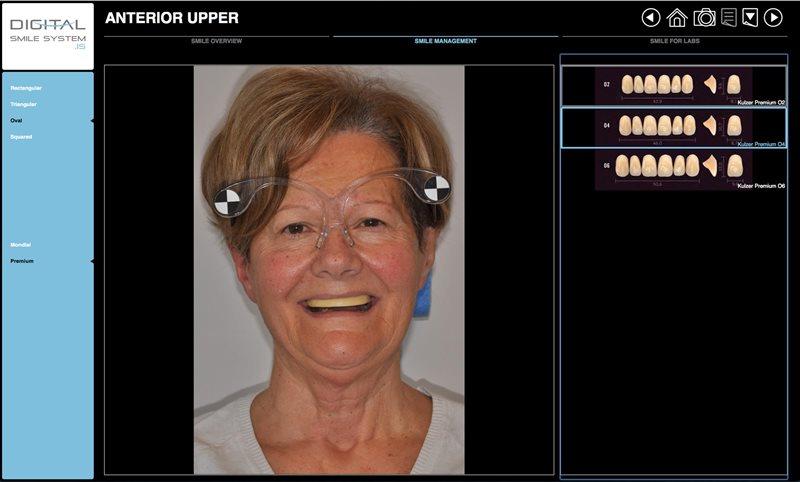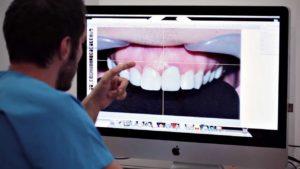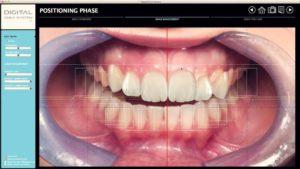The licensed Digital Smile System 2020 is a modern system that allows the patient, doctor and dental laboratory workers to simulate the final result of dental restoration in advance. The DSS system is an innovative development in the field of aesthetic dentistry. At its core, this system is a computer program that, using your photographs and wishes for the final look of your smile, simulates the result of the dentists’ work. The main advantage of this technique is the modeling of the final result individually for each patient, taking into account the structural features of his dentition and facial expressions. It is also important that the program will offer you several different options, and you can choose the one that suits you best.
Using this licensed tool, the dentist will be able to present the patient with a preview of the result of the prosthetics and provide the dental technician with all the information needed to complete the work.
- Special glasses allow you to take a photo of the patient correctly. With reference points, the software makes accurate measurements and tracks parameters such as symmetry, overlap and proportionality.
- Only two images are needed to implement the project, a smiling face of the patient and an intraoral photograph.
But if required, additional patient photos can be uploaded for further work.
- The program has built-in tooth libraries, as well as the ability to create custom libraries. allow you to meet all the needs of the patient. In addition, the Digital Smile System also has additional tools such as outlines, perfect smile lines and the golden ratio to assist the user in design.
Collaboration between doctor, patient and dental technician
The advantage of this software opposite to the cracked one is that it is a real opportunity to show the patient the result of the simulation before the treatment protocol is adopted.
In this case, everyone wins: the doctor, since he can be sure of the patient’s positive reaction, the dental technician, who will receive not only the task, but also the visualization of the final result, and, of course, the patient who will not have to worry during the treatment.
Table of Contents
What are the main advantages of a new patch of the Digital Smile System technology?
In addition to a quite simple procedure required to obtain a result using the Digital Smile System, this technology has other significant advantages. These include the following aspects:
Get results quickly. It only takes a few minutes to process photos with a computer program. Thus, you will receive an electronic image of your teeth after restoration in the shortest possible period of time.
Adaptation of the program to any individual structural features of the patient’s dentition. Due to the presence of a huge number of variations in the final results in the program, it can choose the best one for you, depending on the size, condition, shape and proportions of your teeth.
Versatility. The Digital Smile System helps you to better accomplish many aspects necessary for effective dental treatment and restoration. With the help of this technique, it is possible to avoid problems in diagnosis, possible misunderstanding by the dentist of the patient’s final wishes, as well as by the patient himself of the possibilities of dentistry in solving his problems.
Availability of this modeling technique. Since the procedure itself is quite simple and does not require special equipment or a lot of time, the price for its implementation always remains quite affordable.
Compactness. Another advantage of conducting procedures using the Digital Smile System technology is the compactness of the equipment required for research and analysis of the result. Unlike various outdated technologies, digital smile design does not require bulky, inconvenient devices. Thus, the procedure is completely comfortable for both the doctor and the patient.
Full restoration of a solid bridge prosthesis
New technologies make it possible to transfer traditionally manual processes to the computer. In this way, a much more efficient workflow can be achieved, which saves time and costs.
The first step in dentistry is to assess the clinical situation. Particularly for critical restorations, this protocol starts with patient image management. With only two images (photographs) of a patient, a photograph of his smiling face and the intraoral cavity, you can easily create a clinical, functional and aesthetic smile design using an innovative software called the Digital Smile System (DSS) 2020.
Through a guided workflow, the licensed software allows the user to quickly test with a virtual smile, “trying on” it on the patient’s face, with autonomous digital processing control. With marker glasses, DSS can automatically align two images and disc design. This special calibration system allows users to study the morphology of the patient’s face and obtain highly accurate measurements to facilitate the work of the dentist and technician.
For patients who are missing all teeth, the instrument provides a preliminary overview of the denture options that are suitable for the patient. At the initial planning stage, computer modeling methods, and in particular DDS, have a huge advantage both for work planning and for information.
In fact, it simplifies the dentist’s work – you can immediately present the final result of the patient’s prosthetics and provide the necessary information for the dental technician to manufacture the implants.
After completing the preliminary visualization, the dental arch design is prepared for transfer to the CAD system. Combined directly with DentalCad software, DSS can automatically export 3D compatible output to support CAD modeling.
After completing the preliminary visualization, the dental arch design is prepared for transfer to the CAD system.
The usage of a new patch of the Digital Smile System provides numerous advantages, in particular, the reproducibility of the developed forms and prototypes. The resulting prototype can be considered final, which greatly simplifies the procedure for creating a restoration; The project files will be stored digitally and in addition, the patient will receive a preview of the imaging using the prototype. The prototype is also very important for the dentist’s work to control the relationship between teeth and lips (in terms of aesthetics, phonetics and soft tissue support).
The steps of a treatment with the Digital Smile System
The first step is to consult a patient with a dentist. At this stage, the patient, with the help of a doctor, must decide on the type of restoration and his main wishes regarding the final result.
The second stage is photography. To obtain the result, several photographs are required with special glasses designed by DSS to display symmetry. The photo should show the patient’s face while smiling, and intraoral photos will also be required.
The third stage consists in direct analysis of the obtained images using special software. The analysis can be carried out easily using a tablet or personal computer.
The fourth stage is to analyze the results obtained using the program. Since the DSS technique is designed to simulate the best possible result, it will give you some of the best options. Further, a specialist at the Esthetic Dental Clinic and a dental technician will help you make the right choice, as well as provide advice on the advantages and disadvantages of each option from an aesthetic and functional point of view.
The fifth and final stage is communication between dentist, dental technician and patient at all stages of work.
The main goals of the development of the Digital Smile System
This technology was developed by one of the renowned Brazilian dentists and dental technicians. Carrying out the necessary research and development, its author pursued the following main goals:
- Assisting the dentist in the planning of dental restoration and treatment
- Development of an additional tool for the dentist in planning the appearance of the patient’s future smile.
- Improving and accelerating the process of communication between dentists of different specialties and dental laboratory workers. The presence of such a simulation will be especially useful when the treatment program changes for one reason or another.
- Facilitating, through the program, the correct understanding between the attending physician and the patient regarding the desired appearance after the restoration of the teeth.
- An accurate and detailed analysis of the individual characteristics of the facial muscles and the dentition, taking into account all the wishes of each individual patient in order to select the best option for you.
Using the Digital Smile System in the creation of physical models of the dentition
Perhaps this technology would not have been so popular if it were not for the opportunity to use it in the development of real dental models after the restoration. But one of the most important advantages of DSD is the ability to export images obtained as a result of processing by the program to create physical layouts using other specialized programs such as CAD / CAM, etc.
That is, this system is not only focused on the patient and his need to see the result of restoration and treatment even before the doctors began their work. This licensed software is primarily designed to help doctors and patients find a common language, as well as doctors of different specializations in the correct understanding of each other. With the help of this program, dental technicians will be able to accurately recreate the desired tooth design after restoration, taking into account all the individual characteristics and wishes of the patient. Using the Digital Smile System software will make the dental restoration process easier, faster and more convenient.





